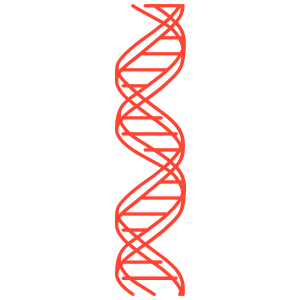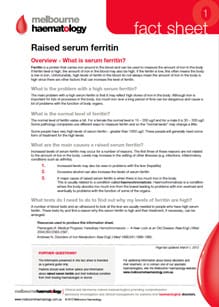Overview
Haemochromatosis is a condition caused by too much iron in the body. People with haemochromatosis absorb too much iron from the intestine.
What causes Haemochromatosis?
The most common form of haemochromatosis is caused by a gene change (mutation) in the protein that control iron absorption in the intestine. The gene change is called the C282Y mutation. This mutation causes one of the proteins in the lining of the intestine to not work properly causing too much iron to be absorbed.
There is another gene change called the H63D gene change that may be associated with a small risk of developing haemochromatosis.
How did I get haemochromatosis?

Haemochromatosis is genetic disorder
Haemochromatosis occurs when you have two copies of the abnormal gene (C282Y); you will have inherited a copy of the C282Y gene from each of your parents. Your parents may have only one copy of this gene mutation and so will not have developed haemochromatosis.
How common is haemochromatosis?
The incidence of the presence of the genes that cause haemochromatosis are quite common – between 1 in 10 and 1 in 20 people will carry one copy of this gene (the other gene is normal). These people will not develop haemochromatosis because you need two copies of the abnormal gene to develop haemochromatosis.
About 1 in 400 people carry two copies of the abnormal gene. The gene change is much more common in people who come from Northern Europe.
Symptoms & Diagnosis
What type of problems result from having haemochromatosis?
The body needs a certain amount of iron to function properly. Iron is used by many of the body systems including the blood, bone marrow and brain.
The amount of iron in the body is usually very closely regulated; too much iron is not good for the body. Too much iron can cause a number of body systems to not work properly including the heart, pancreas (organ in the abdomen that controls insulin production), hormone glands (pituitary gland) and the liver. Patients with too much iron in the body may develop problems in these organs.
Some people with high iron levels may experience tiredness, lack of energy, joint pains and the skin turning a darker color (hyperpigmentation).
What are the normal levels of iron in the body?
We measure iron in the body using a blood test called serum ferritin.
Ferritin is a protein in the body that carries iron around the body – a high serum ferritin is usually a sign of too much iron in the body.
mcg/l
mcg/l
mcg/l
Treatment & Management
What is the treatment for haemochromatosis?
What do I have to do now?
Once you have been diagnosed with having too much iron, you may need to discuss with your doctor having iron removed from your body using venesections* .
*Venesections are the opposite of a blood transfusion – i.e blood is removed from your body.
- Blood contains a large amount of iron and venesections are the easiest way to reduce the amount of iron in the body.
- It is also important to do a range of tests (blood tests, x-rays and possibly ultrasounds) to determine if the increased iron has caused any problems in the organs known to be affected by high iron levels.
How often do I need to have venesections?
The frequency of requiring a venesection will depend on how high your iron levels are.
- Some people may initially need very frequent venesections – even every week if the iron levels are quite high.
- Once the iron levels are low, you may need regular venesections (e.g. every 3 – 4 months) to stop your iron levels increasing again.
Can my blood be used at the blood bank?
The Australian Red Cross Blood Service / Lifeblood (ARCBS) offers a venesections service for patients with haemochromatosis. The blood collected by the Blood Bank can be used in some circumstances. Your doctor may refer to the ARCBS venesections but you will need to fulfill the criteria for regular blood donors to take advantage of this service. Your doctor will need to fill out a form from the ARCBS; the medical team at ARCBS will then contact you to arrange your venesections.
XXX High Ferritin App
https://www.lifeblood.com.au/health-professionals/clinical-practice/clinical-indications/high-ferritin
Should I do anything to change my diet?
Changing your diet will only have a limited effect on the iron levels of your body.
- It is recommended however that you reduce your intake of foods high in iron (especially red meat).
- It is also very important that you drink only small amounts of alcohol
– alcohol has the capacity to increase the damage to the liver in patients with haemochromatosis.

How common is Hereditary Spherocytosis (HS)?
HS is relatively common – around 1 person in every 5000 people has HS (around 800 people in Melbourne; population 4 million).
in 5000 people has HS
people in Melbourne
in 5000 people has HS
people in Melbourne
population of Melbourne*
What does having HS mean?
There are three main common problems associated with having HS:
There is another uncommon potential problem for people who have Hereditary Spherocytosis associated with a viral infection called “Slapped cheek”. Slapped cheek is caused by a virus called Parvovirus which can infect bone marrow cells and put the red cell producing cells “to sleep”. Because patients with HS need the bone marrow to be rapidly replacing the fragile red cells, this infection can cause a severe anaemia; patients can become very pale and sometimes even require blood transfusions. Fortunately this problem is uncommon.
Diagnosis
How is Hereditary Spherocytosis diagnosed?
HS is now diagnosed with a simple blood test. It is also important for a doctor to examine patients with HS to see if they are jaundiced or have an increase in the size of the spleen.
Treatment & Management
What do I need to do now that I (or my child) has been diagnosed with Hereditary Spherocytosis?
Most patients with HS do not need to do much about their condition at all. The bone marrow has the capacity to increase the number of red cells it produces many fold and is able to keep up replacing the fragile cells.
A few things may be helpful:
Will I (or my child) need a splenectomy?
Removing the spleen (splenectomy) has been used a lot in the past in the treatment and management of patients with HS; it stops the red cells from breaking down and solves the problems of HS.
Removing the spleen has problems however – the spleen is an important organ in the immune system and patients who do not have a spleen may be prone to getting serious infections. This risk is higher in younger children but may be less than previously expected because of newer vaccinations. It is now generally recommended to avoid splenectomy in children younger than 6 years and to ensure that children who may need a splenectomy have all the appropriate vaccinations.
Another approach for some of these young patients is to remove only a small part of the spleen – partial splenectomy. This is done in a few hospitals and there is some experience to say this may be very helpful for some patients.
Resources used to produce this information sheet.
- Bolton Maggs, PHB Stevens, RF Dodd, NJ Lamont, G Tittensor, P and King, M-J on behalf of the Haematology Task Force of the BCSH. “Guidelines for the diagnosis and management of hereditary spherocytosis”. BJH 2004 126 pp 455 – 474
Further Questions?
The information presented in this fact sheet is intended as a general guide only.
Patients should seek further advice and information about Haemochromatosis and their individual condition from their treating haematologist or doctor.



